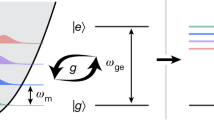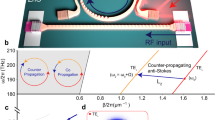Abstract
The parametric coupling of electromagnetic and mechanical degrees of freedom gives rise to a host of optomechanical phenomena. Examples include quantum-limited displacement measurements, sideband cooling or amplification of mechanical motion. Likewise, this interaction provides mechanically mediated functionality for the processing of electromagnetic signals, such as microwave amplification. Here, we couple a superconducting niobium coplanar waveguide cavity to a nanomechanical oscillator, and demonstrate all-microwave field-controlled tunable slowing and advancing of microwave signals, with millisecond distortion-free delay and negligible losses. This is realized by using electromechanically induced transparency, an effect analogous to electromagnetically induced transparency in atomic physics. Moreover, by temporally modulating the electromechanical coupling and correspondingly the transparency window, switching of microwave signals is demonstrated and its temporal dynamics investigated. The exquisite temporal control gained over the electromechanical coupling provides the basis for realizing advanced protocols for storage of both classical and quantum microwave signals.
This is a preview of subscription content, access via your institution
Access options
Subscribe to this journal
Receive 12 print issues and online access
$209.00 per year
only $17.42 per issue
Buy this article
- Purchase on Springer Link
- Instant access to full article PDF
Prices may be subject to local taxes which are calculated during checkout




Similar content being viewed by others
References
Day, P. K., LeDuc, H. G., Mazin, B. A., Vayonakis, A. & Zmuidzinas, J. A broadband superconducting detector suitable for use in large arrays. Nature 425, 817–821 (2003).
Wallraff, A. et al. Strong coupling of a single photon to a superconducting qubit using circuit quantum electrodynamics. Nature 431, 162–167 (2004).
Vion, D. et al. Manipulating the quantum state of an electrical circuit. Science 296, 886–889 (2002).
Clarke, J. & Wilhelm, F. K. Superconducting quantum bits. Nature 453, 1031–1042 (2008).
Houck, A. A. et al. Generating single microwave photons in a circuit. Nature 449, 328–331 (2007).
Majer, J. et al. Coupling superconducting qubits via a cavity bus. Nature 449, 443–447 (2007).
Schoelkopf, R. J. & Girvin, S. M. Wiring up quantum systems. Nature 451, 664–669 (2008).
Mariantoni, M. et al. Implementing the quantum von Neumann architecture with superconducting circuits. Science 334, 61–65 (2011).
Rabl, P. et al. Hybrid quantum processors: Molecular ensembles as quantum memory for solid state circuits. Phys. Rev. Lett. 97, 033003 (2006).
André, A. et al. A coherent all-electrical interface between polar molecules and mesoscopic superconducting resonators. Nature Phys. 2, 636–642 (2006).
Schuster, D. I. et al. High-cooperativity coupling of electron-spin ensembles to superconducting cavities. Phys. Rev. Lett. 105, 140501 (2010).
Kubo, Y. et al. Hybrid quantum circuit with a superconducting qubit coupled to a spin ensemble. Phys. Rev. Lett. 107, 220501 (2011).
Frey, T. et al. Dipole coupling of a double quantum dot to a microwave resonator. Phys. Rev. Lett. 108, 046807 (2012).
Kippenberg, T. J. & Vahala, K. J. Cavity optomechanics: Back-action at the mesoscale. Science 321, 1172–1176 (2008).
Marquardt, F. & Girvin, S. M. Optomechanics. Physics 2, 40 (2009).
Regal, C. A., Teufel, J. D. & Lehnert, K. W. Measuring nanomechanical motion with a microwave cavity interferometer. Nature Phys. 4, 555–560 (2008).
Rocheleau, T. et al. Preparation and detection of a mechanical resonator near the ground state of motion. Nature 463, 72–75 (2010).
Teufel, J. D., Donner, R., Castellanos-Beltran, M. A., Harlow, J. W. & Lehnert, K. W. Nanomechanical motion measured with precision beyond the standard quantum limit. Nature Nanotechnol. 4, 820–823 (2009).
Teufel, J. D. et al. Sideband cooling of micromechanical motion to the quantum ground state. Nature 475, 359–363 (2011).
Massel, F. et al. Microwave amplification with nanomechanical resonators. Nature 480, 351–354 (2011).
Weis, S. et al. Optomechanically induced transparency. Science 330, 1520–1523 (2010).
Safavi-Naeini, A. H. et al. Electromagnetically induced transparency and slow light with optomechanics. Nature 472, 69–73 (2011).
Verhagen, E., Deléglise, S., Weis, S., Schliesser, A. & Kippenberg, T. J. Quantum-coherent coupling of a mechanical oscillator to an optical cavity mode. Nature 482, 63–67 (2012).
Romero-Isart, O. et al. Optically levitating dielectrics in the quantum regime: Theory and protocols. Phys. Rev. A 83, 013803 (2011).
Wang, X., Vinjanampathy, S., Strauch, F. W. & Jacobs, K. Ultraefficient cooling of resonators: Beating sideband cooling with quantum control. Phys. Rev. Lett. 107, 177204 (2011).
Gorodetsky, M., Schliesser, A., Anetsberger, G., Deleglise, S. & Kippenberg, T. J. Determination of the vacuum optomechanical coupling rate using frequency noise calibration. Opt. Express 18, 23236–23246 (2010).
Agarwal, G. S. & Huang, S. Electromagnetically induced transparency in mechanical effects of light. Phys. Rev. A 81, 041803 (2010).
Teufel, J. D. et al. Circuit cavity electromechanics in the strong-coupling regime. Nature 471, 204–208 (2011).
Teufel, J. D., Harlow, J. D., Regal, C. A. & Lehnert, K. W. Dynamical backaction of microwave fields on a nanomechanical oscillator. Phys. Rev. Lett. 101, 197203 (2008).
Kippenberg, T. J., Rokhsari, H., Carmon, T., Scherer, A. & Vahala, K. J. Analysis of radiation-pressure induced mechanical oscillation of an optical microcavity. Phys. Rev. Lett. 95, 033901 (2005).
Schliesser, A., Del’Haye, P., Nooshi, N., Vahala, K. & Kippenberg, T. Radiation pressure cooling of a micromechanical oscillator using dynamical backaction. Phys. Rev. Lett. 97, 243905 (2006).
Gigan, S. et al. Self-cooling of a micromirror by radiation pressure. Nature 444, 67–70 (2006).
Arcizet, O., Cohadon, P-F., Briant, T., Pinard, M. & Heidmann, A. Radiation-pressure cooling and optomechanical instability of a micromirror. Nature 444, 71–74 (2006).
Nayfeh, A. H. & Mook, D. T. Nonlinear Oscillations (Wiley, 1979).
Kozinsky, I., Postma, H. W. C., Bargatin, I. & Roukes, M. L. Tuning nonlinearity, dynamic range, and frequency of nanomechanical resonators. Appl. Phys. Lett. 88, 253101 (2006).
Unterreithmeier, Q. P., Faust, T. & Kotthaus, J. P. Nonlinear switching dynamics in a nanomechanical resonator. Phys. Rev. B 81, 241405 (2010).
Metcalfe, M. et al. Measuring the decoherence of a quantronium qubit with the cavity bifurcation amplifier. Phys. Rev. B 76, 174516 (2007).
Mahboob, I. & Yamaguchi, H. Bit storage and bit flip operations in an electromechanical oscillator. Nature Nanotechnol. 3, 275–279 (2008).
Schliesser, A. & Kippenberg, T. J. in Advances in Atomic, Molecular and Optical Physics Vol. 58 (eds Arimondo, E., Berman, P. & Lin, C. C.) Ch. 5, 207–323 (Elsevier Academic, 2010).
Jiang, C., Chen, B. & Zhu, K. Tunable pulse delay and advancement device based on a cavity electromechanical system. Europhys. Lett. 94, 38002 (2011).
Fleischhauer, M., Imamoglu, A. & Marangos, J. P. Electromagnetically induced transparency: Optics in coherent media. Rev. Mod. Phys. 77, 633–673 (2005).
Longdell, J. J., Fraval, E., Sellars, M. J. & Manson, N. B. Stopped light with storage times greater than one second using electromagnetically induced transparency in a solid. Phys. Rev. Lett. 95, 063601 (2005).
Gröblacher, S., Hammerer, K., Vanner, M. R. & Aspelmeyer, M. Observation of strong coupling between a micromechanical resonator and an optical cavity field. Nature 460, 724–727 (2009).
Wang, Y-D. & Clerk, A. A. Using interference for high fidelity quantum state transfer in optomechanics. Phys. Rev. Lett. 108, 153603 (2012).
Zhang, J., Peng, K. & Braunstein, S. L. Quantum-state transfer from light to macroscopic oscillators. Phys. Rev. A 68, 013808 (2003).
Tian, L. Adiabatic state conversion and pulse transmission in optomechanical systems. Phys. Rev. Lett. 108, 153604 (2012).
Phillips, D. F., Fleischhauer, A., Mair, A., Walsworth, R. L. & Lukin, M. D. Storage of light in atomic vapour. Phys. Rev. Lett. 86, 783–786 (2001).
Palomaki, T. A. et al. State transfer between a mechanical oscillator and microwave fields in the quantum regime. Preprint at http://arxiv.org/abs/1206.5562 (2012).
Fiore, V. et al. Storing optical information as a mechanical excitation in a silica optomechanical resonator. Phys. Rev. Lett. 107, 133601 (2011).
Hoi, I. et al. Demonstration of a single-photon router in the microwave regime. Phys. Rev. Lett. 107, 073601 (2011).
Acknowledgements
T.J.K. acknowledges support by the NCCR of Quantum Engineering, an ERC Starting Grant (SiMP) and the Swiss National Science Foundation (SNF). Financial support from the German Excellence Initiative through the Nanosystems Initiative Munich (NIM) is gratefully acknowledged. Samples were grown and fabricated at the Center of MicroNanotechnology (CMi) at EPFL. The authors acknowledge the assistance of S. Weis, T. Niemczyk and H. Chibani in fabrication, and P. Hakonen and P. Lähteenmäki for measurement in the early phase of the project.
Author information
Authors and Affiliations
Contributions
X.Z. designed and fabricated the samples. The cryogenic measurement set-up was implemented by F.H. and H.H. F.H., X.Z., H.H. and A.S. performed the experiments. X.Z. and A.S. performed theoretical modelling and analysis of the data. X.Z. wrote the paper with guidance from A.S. and T.J.K. All authors discussed the results and contributed to the final version of the manuscript.
Corresponding authors
Ethics declarations
Competing interests
The authors declare no competing financial interests.
Supplementary information
Supplementary Information
Supplementary Information (PDF 1469 kb)
Rights and permissions
About this article
Cite this article
Zhou, X., Hocke, F., Schliesser, A. et al. Slowing, advancing and switching of microwave signals using circuit nanoelectromechanics. Nature Phys 9, 179–184 (2013). https://doi.org/10.1038/nphys2527
Received:
Accepted:
Published:
Issue Date:
DOI: https://doi.org/10.1038/nphys2527
This article is cited by
-
Auxiliary-Cavity-Induced Ultrasensitive and Ultrahigh-Resolution Biomolecule Mass Sensing in a Hybrid Spinning Resonator System
Journal of Russian Laser Research (2023)
-
Microwave Optomechanically Induced Transparency and Absorption Between 250 and 450 mK
Journal of Low Temperature Physics (2023)
-
Ground state cooling of an ultracoherent electromechanical system
Nature Communications (2022)
-
Mechanical frequency control in inductively coupled electromechanical systems
Scientific Reports (2022)
-
A cryogenic electro-optic interconnect for superconducting devices
Nature Electronics (2021)



